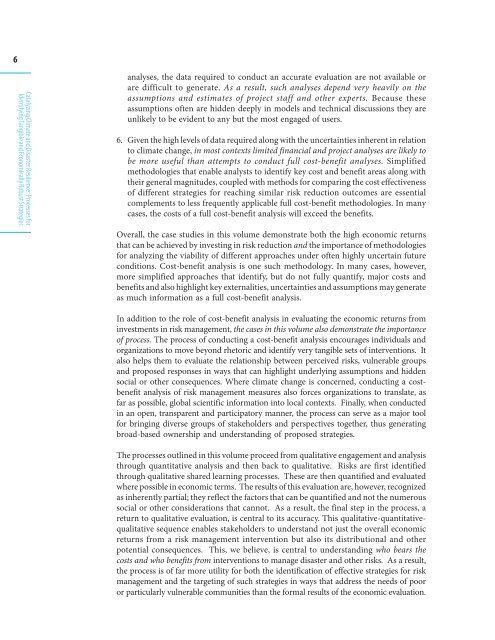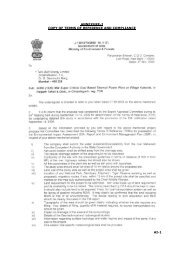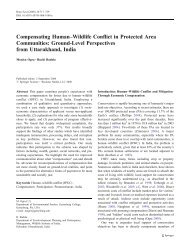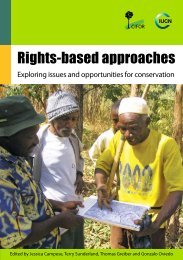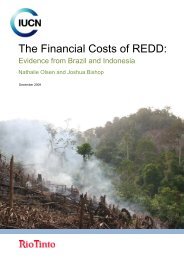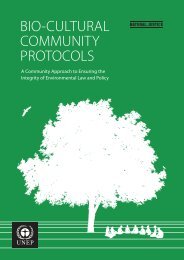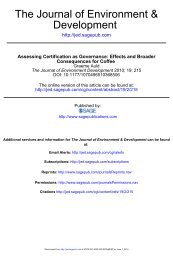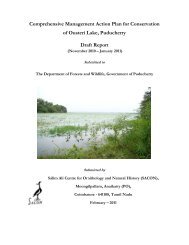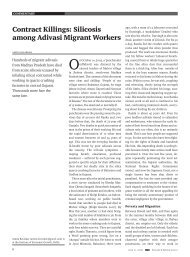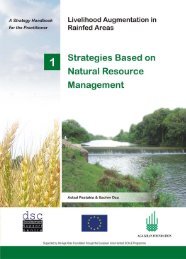Catalyzing Climate and Disaster Resilience: Processes for Identifying
Catalyzing Climate and Disaster Resilience: Processes for Identifying
Catalyzing Climate and Disaster Resilience: Processes for Identifying
Create successful ePaper yourself
Turn your PDF publications into a flip-book with our unique Google optimized e-Paper software.
6<br />
<strong>Catalyzing</strong> <strong>Climate</strong> <strong>and</strong> <strong>Disaster</strong> <strong>Resilience</strong>: <strong>Processes</strong> <strong>for</strong><br />
<strong>Identifying</strong> Tangible <strong>and</strong> Economically Robust Strategies<br />
analyses, the data required to conduct an accurate evaluation are not available or<br />
are difficult to generate. As a result, such analyses depend very heavily on the<br />
assumptions <strong>and</strong> estimates of project staff <strong>and</strong> other experts. Because these<br />
assumptions often are hidden deeply in models <strong>and</strong> technical discussions they are<br />
unlikely to be evident to any but the most engaged of users.<br />
6. Given the high levels of data required along with the uncertainties inherent in relation<br />
to climate change, in most contexts limited financial <strong>and</strong> project analyses are likely to<br />
be more useful than attempts to conduct full cost-benefit analyses. Simplified<br />
methodologies that enable analysts to identify key cost <strong>and</strong> benefit areas along with<br />
their general magnitudes, coupled with methods <strong>for</strong> comparing the cost effectiveness<br />
of different strategies <strong>for</strong> reaching similar risk reduction outcomes are essential<br />
complements to less frequently applicable full cost-benefit methodologies. In many<br />
cases, the costs of a full cost-benefit analysis will exceed the benefits.<br />
Overall, the case studies in this volume demonstrate both the high economic returns<br />
that can be achieved by investing in risk reduction <strong>and</strong> the importance of methodologies<br />
<strong>for</strong> analyzing the viability of different approaches under often highly uncertain future<br />
conditions. Cost-benefit analysis is one such methodology. In many cases, however,<br />
more simplified approaches that identify, but do not fully quantify, major costs <strong>and</strong><br />
benefits <strong>and</strong> also highlight key externalities, uncertainties <strong>and</strong> assumptions may generate<br />
as much in<strong>for</strong>mation as a full cost-benefit analysis.<br />
In addition to the role of cost-benefit analysis in evaluating the economic returns from<br />
investments in risk management, the cases in this volume also demonstrate the importance<br />
of process. The process of conducting a cost-benefit analysis encourages individuals <strong>and</strong><br />
organizations to move beyond rhetoric <strong>and</strong> identify very tangible sets of interventions. It<br />
also helps them to evaluate the relationship between perceived risks, vulnerable groups<br />
<strong>and</strong> proposed responses in ways that can highlight underlying assumptions <strong>and</strong> hidden<br />
social or other consequences. Where climate change is concerned, conducting a costbenefit<br />
analysis of risk management measures also <strong>for</strong>ces organizations to translate, as<br />
far as possible, global scientific in<strong>for</strong>mation into local contexts. Finally, when conducted<br />
in an open, transparent <strong>and</strong> participatory manner, the process can serve as a major tool<br />
<strong>for</strong> bringing diverse groups of stakeholders <strong>and</strong> perspectives together, thus generating<br />
broad-based ownership <strong>and</strong> underst<strong>and</strong>ing of proposed strategies.<br />
The processes outlined in this volume proceed from qualitative engagement <strong>and</strong> analysis<br />
through quantitative analysis <strong>and</strong> then back to qualitative. Risks are first identified<br />
through qualitative shared learning processes. These are then quantified <strong>and</strong> evaluated<br />
where possible in economic terms. The results of this evaluation are, however, recognized<br />
as inherently partial; they reflect the factors that can be quantified <strong>and</strong> not the numerous<br />
social or other considerations that cannot. As a result, the final step in the process, a<br />
return to qualitative evaluation, is central to its accuracy. This qualitative-quantitativequalitative<br />
sequence enables stakeholders to underst<strong>and</strong> not just the overall economic<br />
returns from a risk management intervention but also its distributional <strong>and</strong> other<br />
potential consequences. This, we believe, is central to underst<strong>and</strong>ing who bears the<br />
costs <strong>and</strong> who benefits from interventions to manage disaster <strong>and</strong> other risks. As a result,<br />
the process is of far more utility <strong>for</strong> both the identification of effective strategies <strong>for</strong> risk<br />
management <strong>and</strong> the targeting of such strategies in ways that address the needs of poor<br />
or particularly vulnerable communities than the <strong>for</strong>mal results of the economic evaluation.


